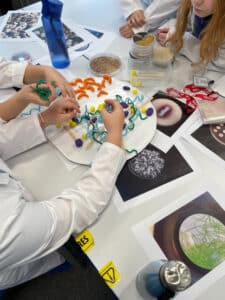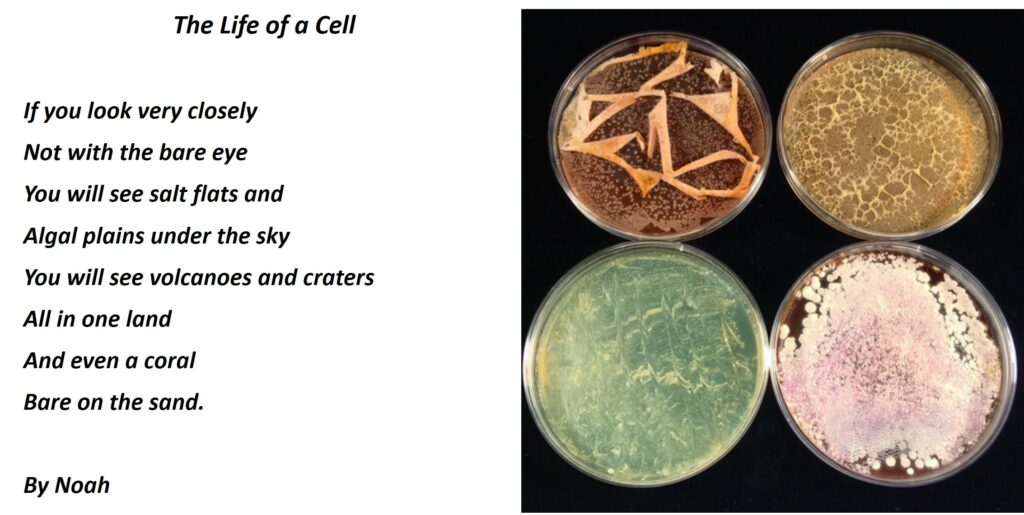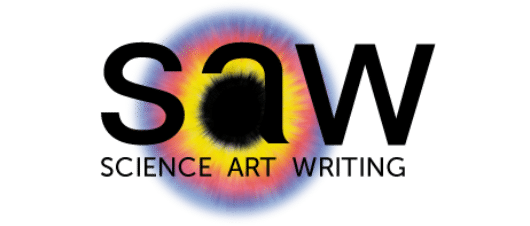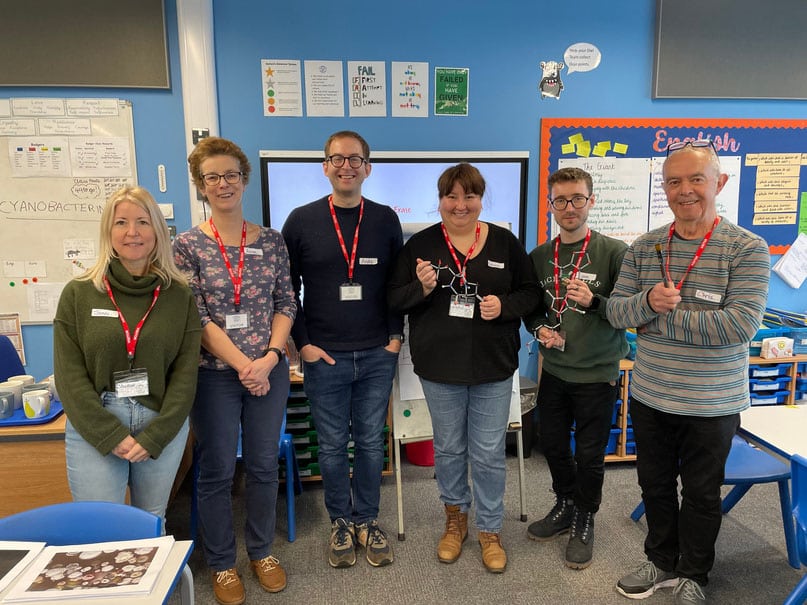In February, we took John Innes Centre scientists, Dr Andy Truman, Dr Natalia Miguel Vior, Liam Chapman, writer (and scientist and SAW founder!) Professor Anne Osbourn and artist Chris Hann, to Barford Primary School to meet Mrs Bunn and her class of year 5 and 6 students, for a day of learning about chemicals made by bacteria.
Like all SAW workshops, the day began with Science. Entering the classroom, the students were met with intriguing science images laid across their tables – this always helps to kick start their curiosity as they start to chatter among themselves, trying to guess what the images might be.

After discussing how we define “living things”, Andy soon got the class thinking about all thing’s microbes, and the children began their first activity, exploring the different shapes of bacteria. Assisted by looking at bacterial plates under the microscope, each group made a collaborative “bacterial plate” using craft materials.
The children discovered that individual bacteria are too small to see with the naked eye and only become visible as a mass when they grow together in colonies. Through some role play activities the class learned that colonies make chemicals that are diffused into their surroundings to stop other bacteria growing near as they compete for space and nutrients. Passing around bacterial plates brought from lab, children were quick to recognise a familiar odour coming from the plates. The smell was a chemical called Geosmin (which means “Geo” Earth; “osme”-odor) that is made by some soil bacteria. The children exclaimed “it smells like the forest”, “it smells like a garden”!
During the next activity, the students “became” bacteria and had to use chemicals to identify members of the same species to form colonies. They loved this silent activity. Each student was given one of three mystery jars (containing either vinegar, peppermint oil or clove oil) and they had to find other children with the same scent to form their colony.
To finish the science session, Andy went on to quiz the class on what they thought DNA was. The class agreed that it was a code of instructions that make you, you. This led them into their final science activity in which they played a card game to find a set of instructions (genes) to make a specific chemical. Cards that resembled parts of a gene pathway of an actual chemical being studied by the scientists were laid face down and they had to collect pairs of genes needed to make the chemical. When they had a full set of pairs, they were given an envelope containing magnetic puzzle pieces to build the chemical structure.
SAW founder, Anne, began the writing session with a warm-up activity using riddles. Reading riddles by the likes of Judith Nicholls and John Cotton, the class had to carefully examine each line and the individual words, to decode the subject matter. They thoroughly enjoyed this and were then tasked with writing their own riddle!
A Riddle by Evie
Ground hopper,
Vegetable nipper,
Long hearers,
Side see-ers,
Hutch liver,
What am I?
Answer: Rabbit
The class then explored vocabulary and techniques used in poetry to paint a picture in the mind of the reader. They looked at the images from the science session and used their imagination and descriptive words to communicate what they could see.

To conclude the cross-disciplinary day, children took part in art activities designed by artist Chis, based on the theme of bacteria.
Created on A3 blotting paper, the children were given a leaf and asked to draw its shape to fill the whole page. Having explained how the use of colour can create contrast and give depth to an image, Chris led the class in using oil pastels to create thick lines and spots to fill the whole leaf. Then using water-based colour pigments, he introduced the class to water/oil resistance, and showed how the water-based colour washed over the oil pastels. The class created some colourful leaf creations!
The last art activity of the day was to create a 3D model of a chemical structure made by bacteria. Using a selection of art and craft materials, the class created their own molecular 3D sculptures.
We had some great feedback from the class and from teacher Mrs Bunn, “The children thoroughly enjoyed the day and engaged with all the activities learning skills they can transfer to their day-to-day learning.
Thank you to Barford Primary School for welcoming us and to Mrs Bunn and her class for such a great workshop.


